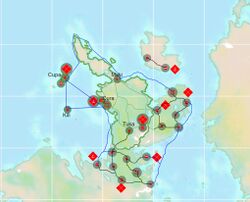User:David/The Mani
| The Mani Empire | |||
| |||
| Motto: Be the best you can be or be nothing at all | |||

| |||
| Capital and Largest City | Cura | ||
| Official language(s) | English | ||
| Official religion(s) | The faith of the elders | ||
| Demonym | Mani | ||
| - Adjective | Mani | ||
| Government | Empire | ||
| - Emperor | TBA | ||
| - Legislature | none | ||
| Establishment | 7/7/2020 | ||
| - Ranked | {{{agerank}}} | ||
| Area | {{{area}}} | ||
| Population | Unknown | ||
| Abbreviation | the Mani | ||
The Mani
The Mani are a people who inhabit the northern part of the southern continent of Philea and a few of its surrounding island. The elders of the Mani claim that their people are the last decedents of the ancient civilisation that build many of the enormous temple that can be found on Philea. If this is true however is hard to say as even the Mani know very little of this ancient civilisation. While extensive studies of the temples are being executed these proceed slowly and yield more speculation than facts. Many of the other cultures that inhabit the continent would state that this claim of ancestry is nothing more than Mani propaganda to try and strengthen their claim to the continent.
Appearance
The Mani have a tanned skin tone. They are generally considered to be rather tall with adults ranging between 1.70 and 2.10 meters in height. The most common hair colours of the Mani are black or brown but a small percentage (+-5%) of the population possesses white hair. They have brown, gold and green coloured eyes. The green coloured eyes are almost as rare as white hair and while they usually manifest together in an individual, they are not mutually exclusive. Being a hard-working active people, the Mani are generally in relatively fit shape and can maintain this good physique until they have advanced far in age. People with excessively fat bodies are often looked down upon as being lazy with the exception of the elderly. The adult members of the Mani race will often Decorate themselves with various types and styles of colourful clothing and an abundance of jewellery. Children, teenagers and young adults also wear brightly coloured clothing, will normally not carry a lot of jewellery around. It is rare to see a Mani in dark or drab clothes or without any gold or crystals adorning their bodies. It should be noted however that some religious orders have adopted these more sombre looks.
Settlements
Cura
The City of Cura is the capital of the Mani empire. It is a large coastal city located on the western side of Ociana. The city of Cura is said to be a giant living artwork. Even through the jungle makes way for the enormous stone temples monuments and luxurious houses the city is still filled with greenery. The Mani planned their capital city with a lot of vegetation in mind. While the trees and bushes might summon images of the unkept jungle in the minds of visitors these are actually well kept and maintained by an army of gardeners that the city employs. The closer one moves towards the harbour the more shops, markets, pubs and restaurants one might notice. During the last century the harbour has become a hotspot of commers as trade and tourism with the rest of the world increased dramatically. The city of Mani also holds the great Mani library. In the last century the library has greatly expanded. When the Jingdao trading partners imported the knowledge of how to make cheaply produce paper a literary revolution began for the Mani population. Every book, scroll and note was copied and preserved in the Great Mani library.
Cupa
Cupa is the second greatest city of the Mani empire. It is located on a large island west of the continent. Its position has allowed it to serve as a trading hub for the Mani empire and the rest of the world. While the older parts of the city have a similar architecture to that of Cura (trough be it to a less grand scale) the newer parts consist of a mix match of newer and foreign styles. This is the result of both foreign traders setting up shop In Cupa and building in the style of their own country of origin. Mani business often also choose to build in foreign or new styles to lure traders and tourists.
Kili
Kili is an island to the west of the continent of Philea. It is the smallest island in the Kili empire that has a settlement on it. As opposed to Cupa Kili has preserved its Mani identity. This is likely do to the fact that Kili sees a lot less trade tan Cupa or Cura. the great stone building that Cura and the older parts of Cupa are know for are also scarce on the island of Kili. While there a few these are even smaller than the ones of Cupa and used for important buildings like temples, markets, courthouses, … Instead the people of Kili live in smaller homes made from natural materials. A lot of the homes are also merged with the jungle itself as three houses are very common on Kili. These houses were maintained, connected and expanded upon over the last century. Kili is known as the tree city island.